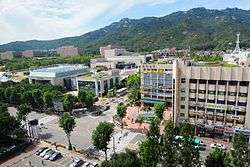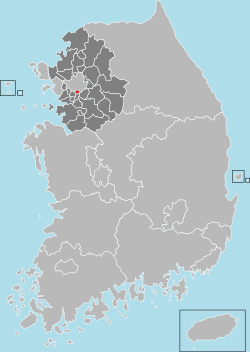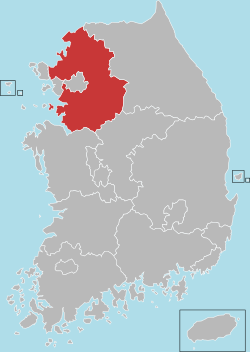Gwacheon
| Gwacheon 과천시 | ||
|---|---|---|
| Municipal City | ||
| Korean transcription(s) | ||
| • Hangul | 과천시 | |
| • Hanja | 果川市 | |
| • Revised Romanization | Gwacheon-si | |
| • McCune-Reischauer | Kwach'ŏn-si | |
 | ||
| ||
 Location in South Korea | ||
| Coordinates: 37°26′N 127°0′E / 37.433°N 127.000°ECoordinates: 37°26′N 127°0′E / 37.433°N 127.000°E | ||
| Country | South Korea | |
| Region | Sudogwon | |
| Administrative divisions | 6 dong | |
| Government | ||
| • Mayor | Yeo In-Kook[1] | |
| Area | ||
| • Total | 35.86 km2 (13.85 sq mi) | |
| Population (2010 Jun) | ||
| • Total | 72,088 | |
| • Density | 2,010.3/km2 (5,207/sq mi) | |
| • Dialect | Seoul | |
| Website | Gwacheon City (English) | |
Gwacheon is a city in Gyeonggi-do Province, South Korea. It lies close to Seoul in the heart of the Seoul National Capital Area, and also lies just east of Anyang. Seoul Subway Line 4 passes through the city.
Various attractions associated with Seoul, including Seoul Grand Park, National Museum of Contemporary Art, Seoul Land, Gwacheon National Science Museum, and Seoul Race Park are located in the city. It is also home to a major administrative center of the Korean government.
History
Early history
In 475 CE, the land that would one day become Gwacheon was a part of Yulmok-gun, a county of the Korean Peninsula's Goguryeo dynasty. Later, in 757, Unified Silla dubbed the area Yuljin-gun, a county of Hansan-ju, and the Goryeo dynasty renamed it Gwaju in 940. From 990 - 994, Gwaju was known by such nicknames as "Bulim" and "Buan." The year 1018 saw Goryeo christen the area Gwaju-hyeon, but the Joseon dynasty changed its name to Gwacheon-hyeon in 1413. Gwacheon-hyeon was a part of Gwangju-mok, Gyeonggi Province.[2] Much larger than today's Gwacheon-si, Gwacheon-hyeon included such territory as modern-day Gunpo.[3]
May 26, 1895 saw Gwacheon-hyeon become Gwacheon-gun, and on March 1, 1914, Gwacheon- and Ansan-gun were annexed to nearby Siheung-gun. The area containing present-day Gwacheon was deemed Gwacheon-myeon, a division of Siheung-gun.[2] Gwacheon-myeon was a large farming village just south of Seoul, as it had been for centuries, and its population had topped 6,000 by the year 1960.[4]
In the 1970s, the South Korean government was considering moving its capital south, to a location farther from the border with and artillery range of North Korea. A complete relocation of the capital proved financially impossible, but a compromise was reached[4] in 1975:[5] move key government agencies several kilometers south of Seoul's downtown, beyond the range of nearly all of North Korea's artillery capability. Gwacheon-myeon, south of both Seoul and the protective Gwanaksan mountain range, was chosen as the site of this new administrative city in 1978, and a groundbreaking ceremony in Gwacheon was held in 1979.[4]
Administrative city
Several government ministries were moved from Seoul to Gwacheon throughout the 1980s and 1990s,[5] and residential districts were constructed to house the employees and their families.[4] The nine million square meter Seoul Grand Park was opened in Gwacheon in 1984 as the new location of Seoul Zoo. Over the next four years, two amusement parks, a botanical garden, and the National Museum of Contemporary Art were also built on the property.[6] On January 1, 1986, Gwacheon was officially elevated to Gwacheon-si (city),[2] and three years later, Siheung-gun was completely disbanded when five other cities in the Seoul National Capital Area were created by the national government.[3]
When Seoul won the right to host the 1988 Summer Olympics, it placed the Korean Racing Association in charge of constructing an Olympic Equestrian Park. 280 acres of land in Gwacheon were thus secured by the KRA, and construction began in 1984. Seoul Equestrian Park hosted several Olympic events in 1988, and after the conclusion of the games, the park was renamed Seoul Racecourse Park and converted into a horse racing facility. Gwacheon accordingly replaced Seoul's Ttukseom area as the city's horse racing hub, and the first race at the new location occurred on September 1, 1989.[7]
Five stations on Seoul Metropolitan Subway's Line 4 opened in Gwacheon on April 1, 1994. The line runs southwest through the city from Seoul into Anyang and includes Seonbawi Station, Seoul Racecourse Park Station, Seoul Grand Park Station, Gwacheon Station, and Government Complex Gwacheon Station.
In 2012, government offices in Gwacheon began relocating to Sejong City, a new administrative capital created by the Korean government in the middle of the country, around 150 kilometers south of Seoul.[8] The move had adverse effects on Gwacheon's local economy, with business such as restaurants and cafes losing considerable portions of their customer base. Fifty-four shops shut down at the end of 2012 and beginning of 2013, while others could no longer turn a profit and were forced to lay off employees. The national government hoped to counter the city's economic crisis by moving fourteen new government agencies to Gwacheon.[9]
Characteristics
Gwacheon intended to have a large importance on governmental construction. There is No.2 government building. So it keeps the position of planned city concerning politics in South Korea. It has been serving as a second center of governmental complex which consists of city hall, welfare management offices, health care department, and many other sub departments of politics.
Seoul Grand Park and Gwanaksan occupy a large portion of the city. The presence of mountains and forests accentuate the status of Gwacheon as a popular destination for Korean nature lovers. In addition, the Seoul Race Park is also located in the city. Gwacheon has few historically preserved sites as well. Gwacheon Hyanggyo (Korean Confucianism institution built in 1389), YeonJudae (YeonJu Temple which is located at the end of cliff), three stepped pagoda of YeonJuAhm, and Portrait of HyoRyung Janggun (general HyoRyung) are listed as treasure of Gyeonggi-do (Gyeonggi Province) and map of Joseon (Old Korean Kingdom) located in History Ministry inside the governmental complex is listed as one of Korean national treasure. In history of Korea, Gwacheon has not only been known as beautiful landscape but also as important center of education and religious practices by Kings.
Also, the first Foreign Language High School established in Gyeonggi-do, Gwacheon Foreign Language High School is located in Jongang-dong. Currently, Gwacheon has Science and Technology Center and one of the biggest public library of Gyeonggi-do.
Residents
Noted graphic artist Dennis Hwang spent much of his childhood in Gwacheon.
Festival
'Gwacheon Festival' was one of the leading street arts festivals in Korea starting from 1997. The festival took place in late September, presenting theater, dance, visual art, music in public space and Korean traditional outdoor theater, etc. The name of the festival has been changed recently from "Gwacheon Hanmadang Festival" to "Gwacheon Festival". The festival aimed at the contribution to the development of street arts and introducing various street arts to Korean audience. The festival also contributed to the international cultural exchange and encourages collaboration between Korean and international artists. Every year, the festival had around 20 Korean companies, 10 from overseas, and more than 100,000 audiences. In March 2015 the Festival changed from street theater to horse attraction, based on a decision of the festival council and on advice of the new mayor of Gwacheon, a lady just elected last year. The artistic director of the festival, YIM su-taek, therefore consequently left the festival, trying to find a new challenge. Website : http://gcfest.or.kr/eng/ [10]
Home stay
Gwacheon city operates a home stay program for foreigners. The city sponsors this program and residents of the city host foreigners living in Korea who want to spend a night in a traditional Korean home. The program helps foreigners understand Korean culture and lifestyle.[11]
Government
The headquarters of the Ministry of Justice is in Building #1 of the Gwacheon Government Complex in Gwacheon.[12] The Korea Correctional Service, an agency of the MOJ, is in this building.[13]
The headquarters of the Ministry of Science, ICT and Future Planning are in Building #4 of the Gwacheon Government Complex.[14]
Several government ministries and agencies formerly residing in Gwacheon are now located in Sejong City. The Ministry of Land, Transport and Maritime Affairs (MLTM, now the Ministry of Land, Infrastructure and Transport or MOLIT) was previously headquartered in the 4th building of the Gwacheon Government Complex,[15] in Gwacheon.[16] Ministry for Food, Agriculture, Forestry and Fisheries (now succeeded by the Ministry of Agriculture, Food and Rural Affairs) also formerly had its headquarters in the Gwacheon Government Complex.[17] Previously the Ministry of Environment had its headquarters in Gwacheon.[18] The Ministry of Strategy and Finance previously had its headquarters in Government Complex II.[19] The Ministry of Trade, Industry and Energy (MOTIE), previously known as the Ministry of Knowledge Economy (MKE) and the Ministry of Commerce, Industry and Energy (MOCIE), was previously located in the government complex in Gwacheon.[20] The Ministry of Employment and Labor (MOEL), previously the Ministry of Labor, was located in Buildings 1 and 3 of the Government Complex II.[21]
Symbol
- Tree : Chestnut
- Flower : Royal azalea
- Bird : Dove
- Animal : Horse
Transportation
Railroad
- (Seocho-gu, Seoul) ← Seonbawi — Racecourse Park — Seoul Grand Park — Gwacheon — Government Complex Gwacheon → (Anyang)
Sister cities
 Airdrie, Canada
Airdrie, Canada Indonesia
Indonesia Nanning, People's Republic of China
Nanning, People's Republic of China Shirahama, Japan
Shirahama, Japan Burlington, North Carolina
Burlington, North Carolina
See also
References
- ↑ "About Gwacheon City: Greeting". Gwacheon City. Retrieved 2014-07-17.
- 1 2 3 "About Gwacheon: History". Gwacheon City. Retrieved 2014-07-17.
- 1 2 "About Gunpo: History". Gunpo City. Retrieved 2014-07-17.
- 1 2 3 4 Andrew Lankov (March 15, 2012). "Gwacheon Complex". The Korea Times. Retrieved 2014-07-17.
- 1 2 "Government Complex Gwacheon: History". Government Buildings Management Service. Retrieved 2014-07-17.
- ↑ "Purpose and History". Seoul Zoo. Retrieved 2014-07-18.
- ↑ "History of Korean Horse Racing". Korean Racing Association. Retrieved 2014-07-17.
- ↑ "Government Complex Begins Move to Sejong City". Arirang News. November 25, 2012. Retrieved 2014-07-17.
- ↑ Choi Mo-ran, Kwon Sang-soo (February 7, 2013). "Gwacheon hit by Sejong City move". Korea Joongang Daily. Retrieved 2014-07-17.
- ↑ Welcome to Gwacheon City
- ↑ http://english.visitkorea.or.kr/enu/SI/SI_EN_3_6.jsp?cid=257603
- ↑ "Location." (Archive) Ministry of Justice (Republic of Korea). Retrieved on January 1, 2014. "Building #1, Gwacheon Government Complex, Jungang-dong1, Gwacheon-si, Kyunggi-do."
- ↑ Home page (Archive). Korea Correctional Service. Retrieved on December 23, 2015. "Building #1, Government Complex-Gwacheon, 47, Gwanmun-ro, Gwacheon-si, Gyeonggi-do, 427-700 Republic of Korea." - Korean address: "[427-700] 경기도 과천시 관문로 47 정부과천청사 5동 법무부 교정본부"
- ↑ "Location Map." (Archive) Ministry of Science, ICT and Future Planning. Retrieved on January 1, 2014. "Government Complex-Gwacheon, 47, Gwanmun-ro, Gwacheon-si, Gyeonggi-do 427-700, KOREA"
- ↑ "img_0104.gif." (Archive) Ministry of Land, Transport and Maritime Affairs. Retrieved on May 11, 2011.
- ↑ "Minister." (Archive) Ministry of Land, Transport and Maritime Affairs. Retrieved on May 11, 2011. "Company Address : 1 Jungang-dong, Gwacheon-si, Gyeonggi-do, Korea (427-760)"
- ↑ "Location." (Archive) Ministry for Food, Agriculture, Forestry and Fisheries. Retrieved on 31 December 2013. "3-108 Gwacheon Government Office Bldg, joongang 1, Gwacheon, Gyeonggi"
- ↑ "Home" (English) (Archive). Ministry of Environment. July 16, 2011. Retrieved on December 31, 2013. "88 Gwanmoon-ro, Gwacheon-si, Gyeonggi-do, 427-729, Republic of Korea"
- ↑ "Location" (English) (Archive). Ministry of Strategy and Finance. April 9, 2011. Retrieved on December 31, 2013. "Ministry of Strategy and Finance, Government Complex II, 49 Gwanmoonro, Gwacheon City, Gyeonggi Province, 427-725, Korea"
- ↑ "Location." (Archive) Ministry of Knowledge Economy. Retrieved on January 1, 2013. "Address Ministry of Knowledge Economy, 88, Gwanmoonro, Gwacheon-si, Gyeonggi-do, Republic of Korea"
- ↑ "Location." (Archive) Ministry of Employment and Labor. April 26, 2013. Retrieved on January 1, 2014. "Address 427-718 Ministry of Employment and Labor. Government Complex II, 47 Gwanmun-ro, Gwacheon-si, Gyeonggi-do, Korea"

